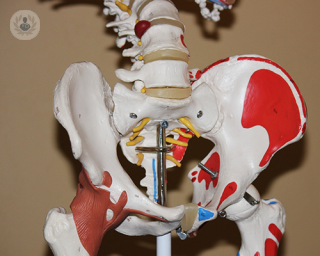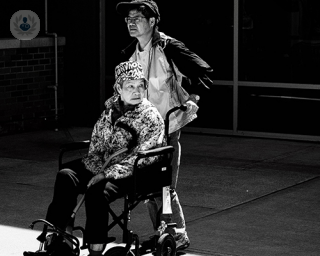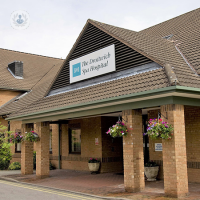What is revision hip replacement?
Hip replacement surgery is a very successful procedure and many patients undergoing a total hip replacement do not experience any problems. Over time, however, it may become necessary for hip replacements to be revised and for further surgery to be performed.

Why is it done?
Most hip revision surgeries are done because the hip has become loose, due to the ball wearing the socket down. This leads to inflammation and the loosening of the socket. Often patients who have had a hip replacement at a young age and those who partake in a lot of physical activity will need a revision hip replacement sooner.
Other reasons that a hip replacement needs to be carried out are:
- The hip has become dislocated due to an infection
- A fracture has caused the hip replacement to require a revision
- Malalignment; the original implant was positioned incorrectly
What does it involve?
Revision hip surgery is a major surgery that can take 3 or more hours. It involves the removal of the old hip and replacing it or restoring the damaged bone.
Most patients will be catheterised during the operation, and the catheter will be removed 2 to 3 days after the operation. Revision hip surgery is more complex, which means that complications can occur more frequently.
How do I prepare for it?
One to two weeks before the surgery, you will be brought into the hospital for an assessment. Routine tests, such as blood tests, urine tests and MRSA screening will be carried out at the hospital. On the day of the surgery, your surgeon will answer any questions that you have and you will meet with the anaesthetist.
Post-operative care
After the operation, your surgeon and physiotherapist will decide how quickly you can bear weight on the hip. Your physiotherapist will teach you how to safely get in and out of bed, the bathtub and car. You will be asked to wear compression stockings for the next six weeks to reduce the risk of developing a blood clot. It will be advisable to sleep on your back and to avoid bending at the hip, twisting your waist and crossing your legs.
When you can safely walk and your wounds are clean and have healed, you will be discharged. Most patients go home 5 to 6 days after the surgery. It generally takes about 6 weeks for patients to walk with one stick and most patients return to work after about eight weeks, depending on how much revision surgery was required.
Revision hip replacement
Professor Lee Jeys - Orthopaedic surgery
Created on: 10-06-2017
Updated on: 08-17-2023
Edited by: Sophie Kennedy
What is revision hip replacement?
Hip replacement surgery is a very successful procedure and many patients undergoing a total hip replacement do not experience any problems. Over time, however, it may become necessary for hip replacements to be revised and for further surgery to be performed.

Why is it done?
Most hip revision surgeries are done because the hip has become loose, due to the ball wearing the socket down. This leads to inflammation and the loosening of the socket. Often patients who have had a hip replacement at a young age and those who partake in a lot of physical activity will need a revision hip replacement sooner.
Other reasons that a hip replacement needs to be carried out are:
- The hip has become dislocated due to an infection
- A fracture has caused the hip replacement to require a revision
- Malalignment; the original implant was positioned incorrectly
What does it involve?
Revision hip surgery is a major surgery that can take 3 or more hours. It involves the removal of the old hip and replacing it or restoring the damaged bone.
Most patients will be catheterised during the operation, and the catheter will be removed 2 to 3 days after the operation. Revision hip surgery is more complex, which means that complications can occur more frequently.
How do I prepare for it?
One to two weeks before the surgery, you will be brought into the hospital for an assessment. Routine tests, such as blood tests, urine tests and MRSA screening will be carried out at the hospital. On the day of the surgery, your surgeon will answer any questions that you have and you will meet with the anaesthetist.
Post-operative care
After the operation, your surgeon and physiotherapist will decide how quickly you can bear weight on the hip. Your physiotherapist will teach you how to safely get in and out of bed, the bathtub and car. You will be asked to wear compression stockings for the next six weeks to reduce the risk of developing a blood clot. It will be advisable to sleep on your back and to avoid bending at the hip, twisting your waist and crossing your legs.
When you can safely walk and your wounds are clean and have healed, you will be discharged. Most patients go home 5 to 6 days after the surgery. It generally takes about 6 weeks for patients to walk with one stick and most patients return to work after about eight weeks, depending on how much revision surgery was required.


How to know if your hip replacement is becoming loose (and what to do about it)
By Mr Adam Cohen
2024-11-21
How does a hip replacement become loose? Mr Adam Cohen explains how this can happen, how common it is and also the necessary treatment. See more


Revision hip replacement: why do hip replacements fail?
By Mr Nick de Roeck
2024-11-21
Hip replacement is generally a very successful procedure in relieving the pain and stiffness associated with a damaged hip joint. However, hip replacements can fail and there are several reasons why this can happen. Expert orthopaedic surgeon Mr Nick de Roeck explains why. See more


Understanding your hip replacement: A guide to the different options
By Mr Andrew Skyrme
2024-11-19
Patients with hip arthritis who have been recommended for hip replacement surgery may be overwhelmed by the variety of options available and the surgery and recovery period to come. In this detailed guide, leading consultant orthopaedic surgeon Mr Andrew Skyrme sheds light on which patients may be most suitable for the various types of hip replacement and explains the steps he takes in his own practice to ensure the best outcomes for his patients. See more


Hip replacement surgery: Expert insight on your treatment journey
By Mr Numan Shah
2024-11-19
We invited esteemed consultant trauma and orthopaedic surgeon Mr Numan Shah to share his expertise on hip replacement surgery and post-operative follow-up. The revered specialist also sheds light on when revision procedures are required. See more
Experts in Revision hip replacement
-
Mr James Donaldson
Orthopaedic surgeryExpert in:
- Hip replacement
- Knee replacement
- Robotic surgery
- Revision hip replacement
- Revision knee replacement
- Knee arthroscopy
-
Mr Constant Busch
Orthopaedic surgeryExpert in:
- Hip replacement
- Knee replacement
- Hip pain
- Knee arthroscopy
- Joint injections
- Revision hip replacement
-
Mr Seb Sturridge
Orthopaedic surgeryExpert in:
- Hip arthroscopy
- Hip replacement
- Revision hip replacement
- Femoro-acetabular impingement
- Knee arthroscopy
- Knee replacement
-
Professor Paul Lee
Orthopaedic surgeryExpert in:
- Hip replacement
- Knee
- Knee cartilage replacement
- Revision hip replacement
- Meniscus
- Anterior cruciate ligament
-
Mr Duncan Whitwell
Orthopaedic surgeryExpert in:
- Bone cancer
- Sarcoma
- Revision hip replacement
- Revision knee replacement
- Knee replacement
- Hip replacement
- See all

OS Clinic
OS Clinic
OS Clinic, 45 Queen Anne St, London W1G 9JF
No existe teléfono en el centro.
By using the telephone number provided by TOP DOCTORS, you automatically agree to let us use your phone number for statistical and commercial purposes. For further information, read our Privacy Policy
Top Doctors

Platinum Medical Centre (HCA)
Platinum Medical Centre (HCA)
15 - 17 Lodge Road
No existe teléfono en el centro.
By using the telephone number provided by TOP DOCTORS, you automatically agree to let us use your phone number for statistical and commercial purposes. For further information, read our Privacy Policy
Top Doctors

The Droitwich Spa Hospital - part of Circle Health Group
The Droitwich Spa Hospital - part of Circle Health Group
St Andrews Rd, Droitwich WR9 8DN
No existe teléfono en el centro.
By using the telephone number provided by TOP DOCTORS, you automatically agree to let us use your phone number for statistical and commercial purposes. For further information, read our Privacy Policy
Top Doctors
-
OS Clinic
OS Clinic, 45 Queen Anne St, London W1G 9JF, W1G Marylebone LondonExpert in:
- Hip
- Minimal access surgery (keyhole surgery)
- Joint preservation surgery
- Maxillofacial Surgery
- Orthopaedic surgery
- Orthopaedic spinal surgery
-
Platinum Medical Centre (HCA)
15 - 17 Lodge Road, Central LondonExpert in:
- Digestive
- Cancer
- Orthopaedic surgery
- Diagnostic Imaging
- Spine
- Physiotherapy
-
The Droitwich Spa Hospital - part of Circle Health Group
St Andrews Rd, Droitwich WR9 8DN, Droitwich SpaExpert in:
- Abdominal ultrasound
- Abdominoplasty
- Vascular Surgery
- Arthritis
- Blepharoplasty
- Hip
- Most viewed diseases, medical tests, and treatments
- Joint pain
- Lumbar herniated disc
- Spinal surgery
- Minimal access surgery (keyhole surgery)
- Shoulder pain
- Osteoporosis
- Botulinum toxin (Botox™)
- Abnormal gait
- Shoulder osteoarthritis
- DEXA scan








